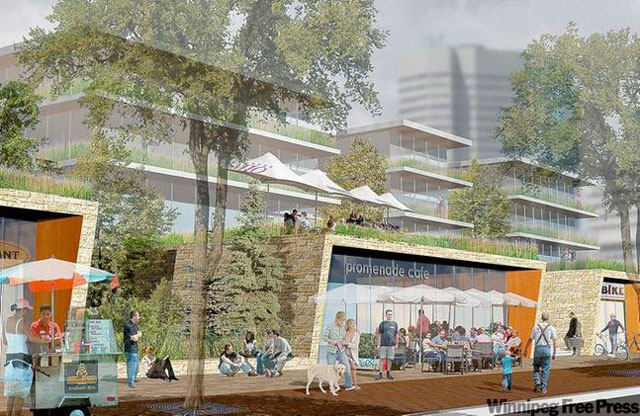
Imagine a city in the not-too-distant future. A medium-sized city, isolated and far from the power centres of the country.
Clinging to the banks of a muddy old river, the evidence of early prosperity is seen in the rail yards, once its lifeblood. For a century, the trains screeched and smoke billowed from the central yard, but when the asphalt railway took over, the area fell silent.
Over the years, the riverside industrial land was reclaimed as a great public space for the city. The old buildings were transformed into markets, and a waterfront walkway and a dramatic new bridge were built. Park space, a hotel, a theatre and restaurants were all part of the plan.
A rapid transit line brought the site to the city. The area changed forever when a world-class museum went up, attracting tourists from around the globe. Embraced as a jewel in the city's crown, it became a source of pride for all.
You are probably wondering where this city might be or you may have already guessed.
It is, of course Bilbao, Spain. With the Guggenheim Museum as a catalyst, their transformation was so profound, cities around the world strive to recreate this success in what has come to be known as the Bilbao Effect.
But the similarities to Winnipeg's Forks site are also obvious and uncanny.
The major difference is in the Spanish city, the final piece of the puzzle was to construct residential buildings transforming the area from a place visited as a destination, to a neighbourhood with its own life and character.
In The Forks' recently released 10-year plan, the large parking lot west of the new museum has been proposed as the site for a sustainable, mixed-use residential and commercial development.
A residential component at The Forks has long been a contentious issue. But transforming the area from a drive-in, drive-out destination into a neighbourhood with a unique personality doesn't mean its public focus must be lost. The success of Corydon Avenue, for example, is due in large part to the surrounding population that supports it. Yet it remains a public amenity for the entire city.
Residential development may not have been perceived as appropriate in the past, but the Canadian Museum for Human Rights might allow it to be compatible with the area in the future.
The museum will bring a scale to The Forks that relates much more to the buildings of downtown than to the market to the south.
This presents an opportunity to develop the sea of parking that currently makes The Forks an island into a higher-density neighbourhood bridging the gap between it and the city centre.
If successful, the vibrancy of The Forks would be introduced to the downtown and some of the urban flavour of the downtown would be brought to The Forks. An increased residential population has always been seen as the key to revitalization in the core. The attraction of the city's new icon provides this opportunity. Connecting The Forks to downtown with residential development would increase pedestrian activity, improve safety at all hours, make the markets more economically viable and enhance the character of both areas.
Cities all across North America are reclaiming the industrial waterfront sites that were the economic engines of the previous century.
With a similar function to The Forks, Vancouver's Granville Island serves as a wonderful example of a dense residential population injecting vitality to a place while preserving a strong sense of public ownership.
Thousands of people live near Granville, yet it remains a place of public gathering and a major tourist draw. The residential component strengthens its presence in the city, while helping to support the markets that remain active long after the tourists have gone home -- something The Forks currently lacks.
The museum's ultimate success will be measured by our ability to translate its impact into a catalyst for farther-reaching development, as they did in Bilbao.
Nowhere is this potential greater than on the adjacent parking lot and its city-owned neighbour to the north.
An open community dialogue and comprehensive planning process would ensure development on both sites is compatible with the public focus of the area, while maximizing the full potential of their location. Enhancing the current amenities at The Forks and affecting a lasting, positive change in the downtown are goals that can be achieved with an appropriate and cohesive plan for the undeveloped land.
An injection of residential vibrancy and urban character at The Forks could transform our city centre into a thriving and dynamic neighbourhood.
If we are able to fully capitalize on this unique opportunity, one day cities around the world may even strive to recreate the Winnipeg Effect.
Brent Bellamy is senior design architect for Number Ten Architectural Group. Contact him at Bbellamy@numberten.com
Republished from the Winnipeg Free Press print edition May 25, 2010 B8